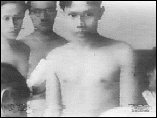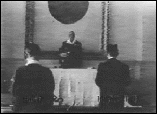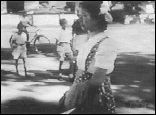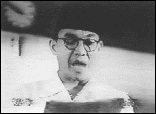|
ロームシャ募集
製作:日本映画社/原題不詳
1944年/日本/インドネシア語/35mm(ビデオ上映)/白黒/6分/提供:オランダ政府情報局映像資料館 |
Call for Romusha (workers)
Production : Nihon Eiga Sha
1944 / JAPAN / Indonesian / 35mm (VTR) / B? / 6 min / Source :
Nederlands Audiovisual Archive |
|
|
ロームシャの生活
製作:日本映画社/原題不詳
1944頃年/日本/インドネシア語/35mm(ビデオ上映)/白黒/11分/提供:オランダ政府情報局映像資料館 |
Daily Life of Romusha (workers)
Production : Nihon Eiga Sha
1944? / JAPAN / Indonesian / 35mm (VTR) / B? / 11 min / Source
: Nederlands Audiovisual Archive |
|
|
南の願望
製作:日本映画社ジャカルタ製作所
1944年/日本/インドネシア語/35mm(ビデオ上映)白黒/10分(部分)/提供:オランダ政府情報局映像資料館 |
Berdjoang (Hope of the South)
Production : Nihon Eiga Sha, Djakarta
1944 / JAPAN / Indonesian / 35mm (VTR) / B&W / 10 min (shortened
version) / Source : Nederlands Audiovisual Archive |
|
|
隣組
製作:日本映画社
1944年/日本/インドネシア語/35mm(ビデオ上映)
白黒/18分/提供:オランダ政府情報局映像資料館
インドネシア人に、日本国内で行われている相互扶助組織の「隣組」を定着させるための映画。 |
Tonari Gumi
Production : Nihon Eiga Sha
1944 / JAPAN / Indonesian / 35mm (VTR) / B? / 18 min / Source
: Nederlands Audiovisual Archive |
|
|
隣組トンガン
製作:日本映画社
1944年頃/日本/インドネシア語、ジャワ語
35mm(ビデオ上映)/白黒/18分
提供:オランダ政府情報局映像資料館 |
Tonari Gumi, Tongan
Production : Nihon Eiga Sha
1944? / JAPAN / Indonesian, Javanese / 35mm (VTR) / B? / 18 min
/ Source : Nederlands Audiovisual Archive |
|
|
八重潮(やえしお)
製作:日本映画社
1943年/日本/日本語、インドネシア語/35mm(ビデオ上映)
/白黒/5分/提供:オランダ政府情報局映像資料館 |
Jaesjo (Yaeshio)
Production : Nihon Eiga Sha
1943 / JAPAN / Japanese, Indonesian / 35mm (VTR) / B? / 5 min
/ Source : Nederlands Audiovisual Archive |
|
|
ジャワ・ニュース2号
[天長節をことほぐ、他]
製作:日本映画社ジャカルタ製作所
1943年/日本/13分/日本語、インドネシア語
35mm(ビデオ上映)/白黒/13分
提供:オランダ政府情報局映像資料館 |
Berita Film di Djawa No.2
(Celebration of the Emperor's Birthday, etc.)
Production : Nihon Eiga Sha, Djakarta
1943 / JAPAN / Japanese, Indonesian
35mm (VTR) / B? / 13 min / Source : Nederlands Audiovisual Archive |
|
|
ジャワ・ニュース7号
製作:日本映画社ジャカルタ製作所
1943年/日本/日本語、インドネシア語/35mm(ビデオ上映)/白黒/11分/提供:オランダ政府情報局映像資料館 |
Berita Film di Djawa No.7
Production : Nihon Eiga Sha, Djakarta
1943 / JAPAN / Japanese, Indonesian
35mm (VTR) / B? / 11 min / Source : Nederlands Audiovisual Archive |
|
 |
ジャワ・ニュース14号
[志願せよ防衛義勇軍、他]
製作:日本映画社ジャカルタ製作所
1943年/日本/日本語、インドネシア語/35mm(ビデオ上映)/白黒/11分/提供:オランダ政府情報局映像資料館 |
Berita Film di Djawa No.14
(Volunteer for the Army, etc)
Production : Nihon Eiga Sha, Djakarta
1943 / JAPAN / Japanese, Indonesian
35mm (VTR) / B? / 11 min / Source : Nederlands Audiovisual Archive |
|
|
ジャワ・ニュース18号
[原住民長官任命さる、他]
製作:日本映画社ジャカルタ製作所
1943年/日本/日本語、インドネシア語/35mm(ビデオ上映)/白黒/8分/提供:オランダ政府情報局映像資料館 |
Berita Film di Djawa No.18
(Nomination of the Native Governor, etc)
Production : Nihon Eiga Sha, Djakarta
1943 / JAPAN / Japanese, Indonesian
35mm (VTR) / B? / 8 min / Source : Nederlands Audiovisual Archive |
|
|
ジャワ・バル4号
[日本におけるインドネシア語学習、他]
製作:ジャワ映画公社
1942年/日本/日本語、インドネシア語/35mm(ビデオ上映)/白黒/12分/提供:オランダ政府情報局映像資料館 |
Djawa Baharoe No.4
(Indonesian Language Training in Japan)
Production : Djawa Eiga Kosha
1942 / JAPAN / Japanese, Indonesian
35mm (VTR) / B? / 12 min / Source : Nederlands Audiovisual Archive |
|
 |
ジャワ・バル7号
[貯金しましょう、他]
製作:ジャワ映画公社
1943年/日本/インドネシア語/35mm(ビデオ上映)/白黒/12分/提供:オランダ政府情報局映像資料館 |
Djawa Bahroe No.7
(Let's Save Money, etc)
Production : Djawa Eiga Kosha
1943 / JAPAN / Indonesian / 35mm (VTR) / B? / 12 min / Source
: Nederlands Audiovisual Archive |
|
|
大東亜ニュース45号
[東条首相のシンガポール訪問]
製作:日本映画社
1943年/日本/無声/35mm(ビデオ上映)/白黒/6分
提供:オランダ政府情報局映像資料館
東条英機首相がシンガポールを訪問した際の記録。自由インド政府軍と首班のチャンドラ・ボースの姿も見える。 |
Khabar Dai Toa No.45
(Tojo Hideki 's Visit to Singapore)
Production : Nihon Eiga Sha
1943 / JAPAN / 35mm (VTR) / B&W
Silent / 6 min / Source : Nederlands Audiovisual Archive
A record of prime minister Tojo's visit to Singapore. Chandra
Bose, the leader of the Freedom Government of India Army can be
seen in this film. |
|
|
インドネシア人の政治関与について
製作:日本映画社ジャカルタ製作所
1943年/日本/インドネシア語/35mm(ビデオ上映)/白黒/9分/提供:オランダ政府情報局映像資料館 |
Political Participation of Indonesians
Production : Nihon Eiga Sha, Djakarta
1943 / JAPAN / Indonesian / 35mm (VTR) / B? / 9 min / Source :
Nederlands Audiovisual Archive |
|
|
南方報道1号
[防衛義勇軍、他]
製作:日本映画社ジャカルタ製作所
1944年/日本/日本語、インドネシア語/35mm(ビデオ上映)/白黒/9分/提供:オランダ政府情報局映像資料館 |
Nampo Hodo No.1
(Volunteer Army for Defence, etc)
Production : Nihon Eiga Sha, Djakarta
1944 / JAPAN / Japanese, Indonesian
35mm (VTR) / B? / 9 min / Source : Nederlands Audiovisual Archive |
|
 |
南方報道特報
[東印度に将来独立を認容]
製作:日本映画社ジャカルタ製作所
1944年/日本/日本語、インドネシア語/35mm(ビデオ上映)/白黒/9分/提供:オランダ政府情報局映像資料館 |
Nampo Hodo Extra (Future Independence of East India)
Production : Nihon Eiga Sha, Djakarta
1944 / JAPAN / Japanese, Indonesian / 35mm (VTR) / B? / 9 min
/ Source : Nederlands Audiovisual Archive |
|
|
インドネシア・ラヤ
製作:日本映画社
1945年/日本/インドネシア語/35mm(ビデオ上映)/白黒/11分/提供:オランダ政府情報局映像資料館
日本政府によるインドネシア独立認容後に、インドネシア人に国歌「インドネシア・ラヤ(大いなるインドネシア)」を普及させるための映画。 |
Indonesia Raya
Production : Nihon Eiga Sha
1945 / JAPAN / Indonesian / 35mm (VTR)/B? / 11 min / Source :
Nederlands Audiovisual Archive
After the Japanese Imperial Government admitted Indonesia's iventual
Independence in the future, this film promote the new Indonesian
national anthem to its people. |
|
|
東条英機のジャワ訪問
製作:日本映画社
1943年/日本/インドネシア語/35mm(ビデオ上映)白黒/7分/提供:オランダ政府情報局映像資料館
1943年7月のニュース映画。造船所やジャカルタ第七国民学校の視察。スカルノの演説。 |
Tojo Hideki's Visit to Djawa
Production : Nihon Eiga Sha
1943 / JAPAN / Indonesian / 35mm (VTR) / B? / 6 min / Source :
Nederlands Audiovisual Archive
Prime minister Tojo inspecting a dockyard and " Kokumin gakko
" (the new term replacing former " sho-gakko " (elementary school)
in 1941). |
|
|
南方の友へ
製作:日本映画社/演出:石本統吉
1941年/日本/日本語、インドネシア語/35mm(ビデオ上映)/白黒/10分/提供:オランダ政府情報局映像資料館
インドネシア、インド、ビルマ、タイ、フィリピン、インドシナ、中国、満洲などから日本に留学しているアジア人学生たちの寮生活などを紹介している。 |
Nampo no Tomo e
(To Our Friends from the South)
Production : Nihon Eiga Sha
Director : Ishimoto Tokichi
1941 / JAPAN / Japanese, Indonesian
35mm (VTR) / B? / 10 min / Source : Nederlands Audiovisual Archive
The students from " The Greater East Asia " are shown. |
|
 |
東亜のよい子供
製作:日本映画社/原題不詳
1944年/日本/日本/35mm(ビデオ上映)/白黒/7分
提供:オランダ政府情報局映像資料館
ジャワの国民学校の子供たちの様子を紹介したもの。インドネシアの子供が歌う日本語の児童唱歌「東亜のよい子供」に合わせて踊る。 |
Good Children of East Asia
Production : Nihon Eiga Sha
1944 / JAPAN / Japanese / 35mm (VTR)
B? / 7 min / Source : Nederlands Audiovisual Archive
A film about children of National elementary school in Djawa.
They are singing a song " Good Children of East Asia. " |
|
|
南方報道26号
[ニッポン語競技会、他]
製作:日本映画社ジャカルタ製作所
1944年/日本/インドネシア語/35mm(ビデオ上映)
白黒/7分/提供:オランダ政府情報局映像資料館 |
Nampo Hodo No.26
(Japanese Speech Contest, etc)
Production : Nihon Eiga Sha, Djakarta/ Original title: unknown
1944 / JAPAN / Indonesian / 35mm (VTR)
B? / 9 min / Source : Nederlands Audiovisual Archive |
|
 |
南方報道43号 特報
[独立準備委員会設立]
製作:日本映画社ジャカルタ製作所
1945年/日本/日本語、インドネシア語/35mm
(ビデオ上映)/白黒/7分
提供:オランダ政府情報局映像資料館
1945年8月、東印度独立準備委員会設立の発表についての報道。撮影されたものの、敗戦となったため上映はされなかった。 |
Nampo Hodo No.43 Extra
(Preparing for Independence, etc)
Production : Nihon Eiga Sha, Djakarta
1945 / JAPAN / 35mm (VTR) / B? / 7 min / Source : Nederlands Audiovisual
Archive
The film records the announcement that the Commitee of Preparation
for Indonesian Independence is founded, in August 1945. Soon after
its prodeuction, the Japanese Imperial government surrendered
to the allied forces, so it remained unreleaced. |
|
|
ボルネオにおける日本軍降伏
撮影:連合軍
1945年/無声/35mm(ビデオ上映)/白黒/5分
提供:オランダ政府情報局映像資料館 |
Surrender of the Japanese Army in Borneo
Photograph: Allied forces
1945 / 35mm (VTR) / B? / Silent / 5 min / Source : Nederlands
Audiovisual Archive |
|
|
シンガポールにおける日本軍降伏
撮影:連合軍
1945年/無声/35mm(ビデオ上映)/白黒/8分
提供:オランダ政府情報局映像資料館 |
Surrender of the Japanese Army in Singapore
Photograph : Allied forces
1945 / 35mm (VTR) / B? / Silent / 8 min / Source : Nederlands
Audiovisual Archive |
|
|
ニッポン・プレゼンツ
製作:オーストラリア軍
1945年/オーストラリア/英語/35mm(ビデオ上映)
白黒/36分/提供:オランダ政府情報局映像資料館
オリジナル・フィルムは日本軍の謀略映画『豪州への叫び声』。 |
Nippon Presents
(aka. Nippon Calls)
Production : Australian Army
1945 / AUSTRALIA / English / 35mm (VTR)
B? / 36 min / Source : Nederlands Audiovisual Archive
The original film was a Japanese strategic film, " Calling Australia.
" |
|
|
天と地の間に
監督:ドクトル・フユン(許泳)
1950年/インドネシア/インドネシア語/35mm/白黒
提供:シネマテーク・インドネシア
協力:釜山国際映画祭
インドネシアの独立を描いた劇映画。監督は日夏英太郎の名で日本の国策映画に従事した朝鮮人許泳(ホ・ヨン)。釜山国際映画祭と共同でニュープリントを復元。 |
Between Sky and Earth
(Frieda)
Director : Dr. Huyung
1950 / INDONESIA / Indonesian / 35mm / B? /Source : Sinematek
Indonesia / Support : Pusan International Film Festival
A feature film which portrays Indonesian independence. The Korean
director, Huyung made several Japanese " national policy " films
under the Japanese name, Hinatsu Eitaro. This print has been restored
in conjunction with the Pusan International Film Festival. |




